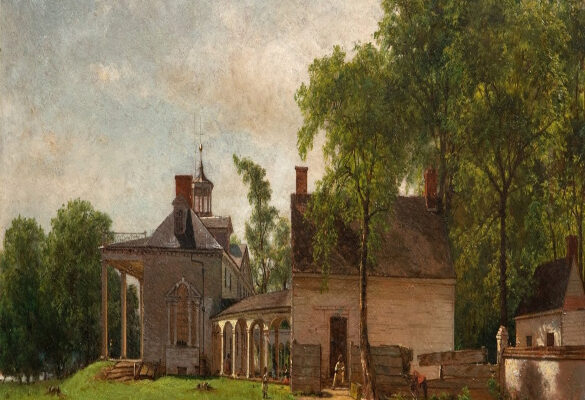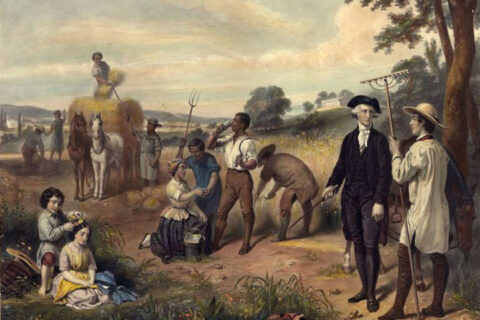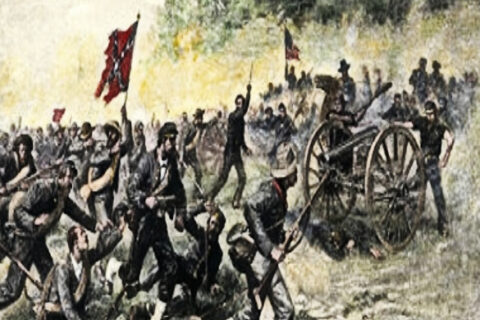The Slave’s Diet
“I think the slaves generally (no one denies that there are exceptions) have plenty to eat; probably are fed better than the proletarian class of any other part of the world.”
Frederick Law Olmsted, A Journey in the Seaboard Slave States
To purchase a costly slave and not feed them would not give the buyer a return on their investment. As owners knew, slaves needed the energy to work. If slaves were underfed, then you would lose out on their potential production. Former Georgia slave Alec Bostwick said, “Dey had to feed us an plenty of it, cause us couldnt wuk if dey didn’t feed us good.” Isaac Johnson of North Carolina said, “I had plenty to eat, good clothes, a nice place to sleep an’ a good time. Marster loved his slaves an’ other white folks said he loved a nigger more den he did white folks.” Virginian John Taylor of Caroline taught, “The farmer who starves his slaves, is a still greater sufferer. He loses the profits produced by health, strength and alacrity; and suffers the losses caused by disease, short life, weakness, and dejection.”
Northerner abolitionist Frederick Law Olmsted said if an owner withheld food from slaves, “He gets the name of a “nigger killer,” and loses the respect of the community.” Rev. H.N McTyeire, in a manual for Christian slave owners on proper care, said in The Duties of Masters to Servants, that since slaves are outside working more than the masters, they should be eating more than the masters. Robert Fogel, in Without Consent or Contract: The Rise and Fall of American Slavery, quotes a master who, when asked why he did not just feed his slaves beef off his farm since it would be cheaper, responded with “simply because it would raise a revolt… fat pork and corn bread is the natural aliment of a negro, deprive him of these, and he is miserable.” This was not an area where an owner could cut corners as if he did, he would lose out in the end.
In Time on the Cross, scholars Robert Fogel and Stanley Engerman write, “The belief that the typical slave was poorly fed is without foundation.” Slaves’ food consumption passed that of the freemen of 1879 by 10%.[1] They ate a variety of fruits, vegetables, meats, and grains, and according to the authors, their diet exceeded the modern recommended daily intake. It exceeded the recommended iron consumption by 230% and protein by 110%. Two separate studies concluded slaves ate around 4,200 calories a day. In The Rise and Fall of American Slavery, Fogel concludes, “There is no question that the slave diet was sufficient to maintain the slave body weight and general health.” Further, slaves were given more nutritious foods than our modern intake. In season, locally grown, non-genetically modified food is far more nutritious than today’s foods. So, the average nutritional intake of the typical slave was even more significant than the studies estimated. Also, these studies did not consider wild game, eating off the plantation’s fruit trees, and fishing. They also excluded the food grown on the individual slaves’ plots of land. The majority of slaves owned or at any rate had the use of a small area of land and usually had a garden and farm animals.
“In the garden of each one of these homes is a pig pen, in which two fine hogs are raised each year by the most thrifty of the servants. Where do they get the grain with which to raise and fatten these pigs? The head of nearly every family has his patch of ground, in which he grows corn, peas and cotton, or any crop he prefers.”
James Battle Avirett, The Old Plantation; How We Lived In Great House and Cabin Before the War
In 1859 T. Addison Richards observed rice plantations in the South. Writing for the New York published Harper’s New Monthly Magazine, he wrote, “Each family of negroes has a house or cabin of its own, generally with sufficient garden-ground, piggery, hennery, and so forth.” Sixty percent of former slaves interviewed in the slave narratives said they had their own section of land that they produced from. Some masters even purchased their produce supply from them.
“They are supplied, even under the requirements of the law, with a reasonable amount of clothing, and ample rations of food are served out every week. These consist chiefly of meal, rice, vegetables, molasses, bacon, fish, and coffee, according to their wants and occupations. Most of them have a surplus of these staple articles of diet, which they exchange at the nearest store for nick-nacks more to their liking. The law forbids the sale of liquor; but they manage, in some way, when so disposed, to get quite enough of it.”
T. Addison Richards, The Rice Lands of the South Harper’s New Monthly Magazine
Slaves were fed well enough that poor local whites would come to the large plantations and beg for food from the slaves. Even famed abolitionist Fredrick Douglass, who often suffered the worst of slavery, said about his diet, “I was much better off in this regard than many of the poor white children in the neighborhood.” Douglass learned to read as a child by trading food for reading lessons among white children in Baltimore.
Living Quarters
According to the Federal Census of 1860, the ordinary plantation contained 5.2 slaves per house compared to 5.3 for whites. It is true that many slaves lived in log cabins, but so did most free whites. Slave cabins often had dirt floors to prevent and protect them from fire; so wooden planking wouldn’t fuel any fire that started. Overall, immigrants and urban workers were in more confined areas than slave quarters. In 1893, a study of New York City workers discovered that they still did not meet the area allotted to slaves living in slave quarters in 1860.
“The difference between us is, that our slaves are hired for life and well compensated; there is no starvation, no begging, no want of employment among our people, and not too much employment either. Yours are hired by the day, not cared for, and scantily compensated… you meet more beggars in one day, in any single street of the city of New York, than you would meet in a lifetime in the whole South.”
James Henry Hammond, “Cotton is King” Speech, 1858
Scientist Sir Charles Lyell said of the slave quarters, “Neat as the greater part of the cottages in Scotland.” Letitia Burwell, who was born and raised on the plantation, wrote of the slave cabins in her diary, later published as A Girl’s Life in Virginia Before the War, “Each cabin has as much pine furniture as the occupants desired… bread, meat, milk, vegetables, fruit, and fuel were plentiful as water in the springs near the cabin doors.” The slave family as a unit was often encouraged by owners, and if slaves were married, they would often receive a house of their own on the plantation.
Medical Care
According to Fogel and Engerman, plantation owners spent more money on medical care for slaves than freemen did on their children. They write, “That adequate maintenance of the health of their slaves was a central objective of most planters is repeatedly emphasized in instructions to overseers and in other records and concordance of planters.” In Jesse James; Last Rebel of the Civil War, author T.J. Stiles, looking at slavery in Missouri, wrote that “most slaves received about as much medical care as their owners.”
Many plantations would have a mini hospital, a full-time nurse, and a doctor who would travel between plantations. Former slave Rachel Adams of Georgia said, “White folks jus had to be good to sick slaves, cause slaves was property. For Old Merster to lose a slave was losin money.” Armstead Barrett of Texas said, “Old massa have doctor for us when us sick. We’s too val’ble,” and former Mississippi slave Henry Cheatam[2] said, “De owners always tuk care of us, and when us got sick dey would git a doctor.”
Self-proclaimed “Yankee” Joseph Ingraham observed plantations in Louisiana and Mississippi. He said, “On large plantations, hospitals are erected for the reception of the sick, and the best medical attendance is provided for them… on some estates, a physician permanently resides… the health of the slaves, so far as medical skill is concerned, is well provided for.”
In the decades following the war, African Americans’ life expectancy dropped by 10%, and sickness rose by 20%. Slaves received better medical care as they were property of a rich planter protecting his investment. Likewise, slaves had clothes and shoes supplied for them. “Servants should be well clothed,” wrote Rev. H.N McTyeire in The Duties of Masters to Servants. “A shivering servant is a shame to any master.”
“They are well fed and warmly clothed in the winter, in warm jackets and trowsers, and blanket coats enveloping the whole person, with hats or woolen caps and brogans. In summer they have clothing suitable to the season, and a ragged negro is less frequently to be met with than in northern cities.”
Joseph Ingraham, The South-West by a Yankee
Slave Labor in the Old South
“Slaves as a rule were neither over-worked nor treated with cruelty. It is absurd to suppose the contrary… Nowhere where the negro is left to himself in Africa has he reached any higher stage of civilization than he possessed as a Southern slave. His hours of labour were shorter, and his diet more plentiful than those of the English agricultural labourer.”
Englishman Henry Latham, Black and White; A Journal of a Three Months’ Tour in the United States
Southern slaves worked 10% fewer hours than Northern farmers and worked 5.4 days a week on average. In Time on the Cross, the authors found that slaves who were either too old or young, usually around 1/3 of slaves on a given plantation, were not working or were doing minimal chores, as was also the case with slaves who were ill. Multiple studies found slaves worked on average only 281 days a year due to the Sabbath off, holidays, weather, and sickness. Northerner Joseph Ingraham observed, “The negroes have several holidays, when they are quite at liberty to dance and frolic as much as they please.” In the often-used Christian manual Duties of Masters to Servants, Rev. H.N. McTyeire tells masters not to work slaves too hard; “not less than seven hours in every twenty-four ought to be spent in sleep,” adding “leisure [is]… necessary to man.”
In Myths of American Slavery, Southern apologist Walter Kennedy quotes 1840s Scottish observer William Thompson as saying slaves don’t work “one fourth so much as a Scotch.” In his 1854 book A South-side View of Slavery, Massachusetts pastor Nehemiah Adams said, “The labor… is no more toilsome than is performed by a hired field hand at the North.” Joseph Ingraham observed a plantation outside of New Orleans and wrote, “Negroes were basking in the evening sun – mothers were nursing their naked babies, and one or two old and blind negresses were spinning in their doors… scattered over the grass, lay half a score of black children, in puris naturalibus, frolicking or sleeping in the warm sun, under the surveillance of an old African matron, who sat knitting upon a camp-stool in the midst of them.” Certainly, they had more leisure than a Northern free farmer.
Some reports of slaves working from sunup to sundown can be misleading, since 2-3 hours were taken off at midday due to the Southern heat. Further farm work depended on the season. During the winter months much less was required, but during harvest, more hours were needed. At harvest time, slaves often worked 70 hours a week. Know what both the free white farmer and slave owners were doing during harvest? Working sunrise to sundown.
Even on the enormous cotton plantations, there was a wide variety of jobs offered to the slaves. Letitia Burwell named among the occupations on her mother’s plantation “Blacksmiths, carpenters, masons, millers, shoemakers, weavers, spinners, all working for themselves.” Joseph Ingram noticed on plantations “blacksmith, cabinet-maker, carpenter, builder, wheelwright mechanics, draymen, hostlers, laborers, hucksters, and washwomen mechanics, cooks, waiters, and nurses.” Jobs and pay varied, and hardworking slaves were rewarded with higher-level jobs such as running the plantation or by receiving more gifts, even freedom.
Slave “renting” was common; this is where a skilled slave (carpenter, blacksmith, etc.) would be elevated to a semi-vassal. He became autonomous, often living off-site, making his own arrangements with customers, and paying back a percentage of his income to the owner. These slaves often lived entirely separately from their owners, owning a house or renting in urban areas. Slaves started dominating specific trades in cities, causing Southern whites to get upset at the slave owners because the slaves were taking all the jobs.
Working in the field picking cotton is often seen as the worst form of labor a slave would endure, yet even here, Joseph Ingraham wrote, “The first day in the field is their proudest day. The young negroes look forward to it, with as much restlessness and impatience as school-boys to a vacation. Black children are not put to work so young as many children of poor parents at the North.” Former slave Rachel Adams of Georgia said, “Cotton pickin’s was big fun too, and when dey got through pickin’ de cotton dey et and drank and danced ‘til dey couldn’t dance no more.” Former slave Ellen King of Mississippi, said, “When I sits and thinks of all the good things we had to eat and all the fun we had, ‘course we had to work, but you knows, when a crowd all works together and sings and laughs, first thing you know–works done.”
Often slaves gained extra cash from their own business on the side. Joseph Ingraham wrote, “It is customary for planters in the neighborhood to give their slaves a small piece of land to cultivate for their own use, by which, those who are industrious generally make enough to keep themselves and their wives in extra finery and spending money throughout the year.” Some would purchase their freedom. Ingraham wrote, “I have never known a planter refuse to aid, by peculiar indulgences, any of his steady and well-disposed slaves, who desired to purchase their freedom.” In his book Myths of American Slavery, Walter Kennedy looks at store records in Germantown, Louisiana. There, local slaves maintained their own accounts at the stores and freely made purchases at the stores. During free time slaves worked at these local stores earning the same wages as whites. Slaves sold goods to the store they made or grew in their downtime from their property. Slaves purchased “luxury” and “snack” items since all the necessities of life were provided by the master, such as housing, job, payment, food, medical care, etc. The slaves also bought gun powder, knives, and writing utensils. Slave owner Daniel Hundley said, “There is not an adult male slave in the entire South, provided he possess the necessary energy, who cannot lay up more ready money in a twelvemonth than most day-laborers in the North.” A former South Carolina slave said, “If we had not been set free in 1865, you would have discovered many wealthy black slaves laden with money we had made from our extra crop production.” Former Alabama slave Simon Phillips said that other ex-slaves used to lend his master money when his master was “hard pushed.” Many slaves would purchase their freedom and their own slaves to begin a plantation for themselves. Virginian R.L. Dabney wrote, “Slaves received, on the average, better and more certain compensation [for work] than any labouring people.” In the book Time on the Cross, the authors stated, “The typical slave hand received about 90% of the income he produced.”
With current tax rates, few can keep that percentage from our masters, the federal government.
[1] Statistics on slavery are derived from Time on the Cross; The Economics of American Negro Slavery by Nobel Prize-winning historian and economist Robert Fogel and economist Stanley Engerman and Without Consent or Contract; The Rise and Fall of American Slavery by Robert Fogel. Myths and Realities of American Slavery by John Perry makes excellent use of census data and will be another source.
[2] Mr. Cheatam’s story however is in the Alabama LoC narratives, he having removed there after freedom.

Jeb Smith is the author of four books, the most recent being Missing Monarchy: Correcting Misconceptions About The Middle Ages, Medieval Kingship, Democracy, And Liberty. Before that, he published The Road Goes Ever On and On: A New Perspective on J. R. R. Tolkien and Middle-earth and also authored Defending Dixie’s Land: What Every American Should Know About The South And The Civil War, written under the name Isaac C. Bishop. Smith has authored dozens of articles in various publications, including History is Now Magazine, The Postil Magazine, Medieval History, Medieval Magazine, and Fellowship & Fairydust and featured on various podcasts including The Lepanto Institute.






Thanks for taking the time to put this together. Important for obvious reasons. If Antebellum slavery were a job description today, you’d have infinite applicants. All the benefits of a military contract without the danger.
That is an interesting way to look at it. In a future article I contrast the modern workers day to that of a salve!
I hope you’ll be going into a detailed history of when and how the record got distorted so badly. That would be very much apprechiated.
Others would know better than I, but it seems around World War II when that occurred after the last of those who lived during slavery and the Civil War passed away.
The timing would have been perfect for two reasons: 1) all those who could contradict the narrative would have passed on. 2) There was a need to shape a new narrative as a distraction from the reality of how the victorious Allied Powers (not just Russia) were employing slave-labor of POW’s and non-combatants in defeated nations (whom Eisenhower reclassified as Displaced Enemy Persons to circumvent the the protections of the Geneva Convention and the Red Cross). Patton saw it, called it a hypocritical disgrace, and was silenced permanently.
It was the old “nothing to see here folks” ploy. And the public mind never knew or cared because they were redirected to a new false narrative about how poorly the slaves had been treated in the old South.
German Confederate, great article by Mr. Smith.
I’m still reading, Medieval Cities, Their origin and revival of Trade by Henri Pirenne, it relates how the merchants took over some cities. I decided to peek into this book i have called ‘The hundred years’ by Philip Guedalla, copywrite 1936-1937. It is as you say, the chapter 1861, starts off with St. Petersburg, and relates how the czar made the serfs/slaves equal to the Nobleman, the next entry is called Charleston S.C., to qoute from the book ‘ To traders with interest in a dozen states the union was something more than a constitutional formality, since it created the territorial unit within which they were at liberty to operate. It was impossible for Northerners to trade with the expanding west without developing a national conception of the union transcending their municipal attachment to the state in which they lived. Commerce, in fine, enlarged their loyalties and, finding them New Yorkers, made them Americans’. More quotes guaranteed to make a Southrons blood boil in that chapter, let me tell you.
Thought I’d share that book with you.
It’s eerily familiar to the book i first mentioned.
God Bless you Sir.
God bless you as well, and thank you for the recommendation.
Have a wonderful new years
I just finished Michael Walsh’s ‘Witness to History’, Vol. 4. Not for the faint of heart. It’s nauseating what they did to the German people. Such Satanic hatred can only issue from a hellish envy, reminding me of Iago’s line in Othello: “he hath a daily beauty in his life that makes me ugly.” -Othello, Act 5, scene 1. It has relevance to this site in that one can detect the same evil operating in Sherman and the movers behind Reconstruction of the South.
Apologies in advance for polluting your comment thread with long-winded garbage like the following, but your compilation of quotations favorable to Southern slavery and Southern slaveholders brought it to mind, and I couldn’t resist. It is excerpted from the introduction to John McElroy’s Andersonville: A Story of Rebel PrisonsWhen the anti-slavery reformers of thirty years ago set forth the cruelties of the slave system, they were met with a storm of indignant denial, vilification and rebuke. When Theodore D. Weld issued his “Testimony of a Thousand Witnesses,” to the cruelty of slavery, he introduced it with a few words, pregnant with sound philosophy, which can be applied to the work now introduced, and may help the reader better to accept and appreciate its statements. Mr. Weld said:
“Suppose I should seize you, rob you of your liberty, drive you into the field, and make you work without pay as long as you lived. Would that be justice? Would it be kindness? Or would it be monstrous injustice and cruelty? Now, is the man who robs you every day too tender-hearted ever to cuff or kick you? He can empty your pockets without remorse, but if your stomach is empty, it cuts him to the quick. He can make you work a life-time without pay, but loves you too well to let you go hungry. He fleeces you of your rights with a relish, but is shocked if you work bare-headed in summer, or without warm stockings in winter. He can make you go without your liberty, but never without a shirt. He can crush in you all hope of bettering your condition by vowing that you shall die his slave, but though he can thus cruelly torture your feelings, he will never lacerate your back—he can break your heart, but is very tender of your skin. He can strip you of all protection of law, and all comfort in religion, and thus expose you to all outrages, but if you are exposed to the weather, half-clad and half-sheltered, how yearn his tender bowels! What! talk of a man treating you well while robbing you of all you get, and as fast as you get it? And robbing you of yourself, too, your hands and feet, your muscles, limbs and senses, your body and mind, your liberty and earnings, your free speech and rights of conscience, your right to acquire knowledge, property and reputation, and yet you are content to believe without question that men who do all this by their slaves have soft hearts oozing out so lovingly toward their human chattels that they always keep them well housed and well clad, never push them too hard in the field, never make their dear backs smart, nor let their dear stomachs get empty!”
In like manner we may ask, are not the cruelties and oppressions described in the following pages what we should legitimately expect from men who, all their lives, have used whip and thumb-screw, shot-gun and bloodhound, to keep human beings subservient to their will? Are we to expect nothing but chivalric tenderness and compassion from men who made war on a tolerant government to make more secure their barbaric system of oppression?
That’s a peach pregnant with sound reasoning and sound philosophy if I ever read one! Ha, ha.
Good work.
I think the logic is good but the circumstances and facts fail to meet reality
Thank you for your comment and quote. I think it is a perfect example of the misunderstanding of what slavery in the south was. I once read a southern apologist who wrote when you read northern sources on slavery, your not reading about slavery in the south, but in ancient pagan times. I think your source demonstrates that perfectly. Luckily truth and facts are not easy to hide and thus, can be known, lies exposed.
My intro to the above excerpt somehow got cut short. It should read as follows:
Apologies for polluting your comment thread with long-winded garbage like the following, but your compilation of quotations favorable to Southern slavery and Southern slaveholders brought it to mind, and I couldn’t resist. It is excerpted from the introduction to John McElroy’s book,Andersonville: A Story of Rebel Prisons, introduction by Robert McCune. McCune is herein invoking abolitionist leader Theodore Weld’s “sound philosophy” in vindication of McElroy’s unhinged, hate-filled ravings against all things Southern, liberally interspersed throughout the book.
Also, everything that follows, minus the last two lines which are mine, should have appeared in blockquotes, not italics. That it appears as it does in the comment (italicised) likely means that I failed to add in the coding correctly in some way and didn’t check it closely enough before hitting the “send” button. Oh well, no harm no foul, I guess, but I mean, … slowww dowwwn, Morris!
Thanks for the quote and comment. I think the logic is sound but the facts are off!
I read a “lost cause” author who made the claim that when you read pro North writings about slavery, you are really reading about ancient slavery during Pagan times.
I think the source you provided is a perfect example. But lucky for us, we have facts and truth that can dispel myths!
Mr. Smith,
I asked you a question on your General Mac article about a French-English connection, and you graciously replyed that you did not know, from the book i mentioned above, ‘The hundred years’ chapter 1861, subtitle Osborne, p.107.
Reference to Lord Palmerston-
Indeed, his main preoccupations as the year went out were trans-atlantic. For the civil war was on, and neutrality is never easy for maritime powers. A northern cruiser had committed the inexcusable irregularity of stopping a British mail-steamer and removing four Southern passangers by force. The names of captain Wilkes, the Trent, and Messrs. Slidell and Mason acquired a feverish notoriety, as a sharp argument proceeded between Washington and Downing street. War-correspondents hopefully began to study the American campaign of 1812, and the Guards sailed for Canada. Lord Palmerston dropped in one evening at the Confederate offices in Suffolk street, Pall Mall, and had a most excited talk about the possibilities of armed Franco-british intervention to stop the war; and Lincoln in his yokel phase was slightly irritating to the Queens minister at Washington with a vague assurance, when pressed about the burning question, “Oh, that’ll be got along with”. But the cabinet was cautious; the law was on their side; a draft despatch of Russell’s was discreetly modified, toned down still further by the Prince Consorts failing hand, and rendered even milder by a last revision in cabinet; and as Secretary Seward intimated that his prisoners would be set free, the war-cloud passed. That anxious piece of drafting had been the prince’s last public work. Now the queen was quite alone in the bewildering solitude of Palmerstonian England and the Europe of the Second Empire, alone among her crowding memories of his ideals that had been so noble and his opinions that had been so precise; and the short winter afternoon was over, as the tide ran mournfully through Spithead beneath the windows of the house that he built.
I thought I would share that with you Mr. Smith, thank you for your reply.
Happy New Year to you Sir and God Bless You and Your work.